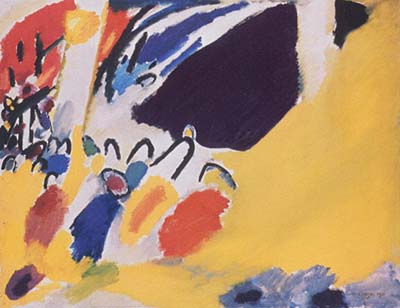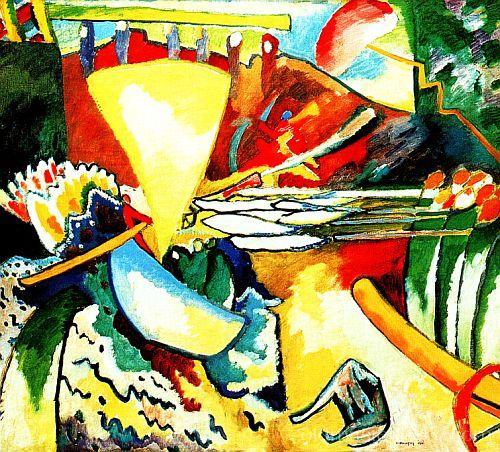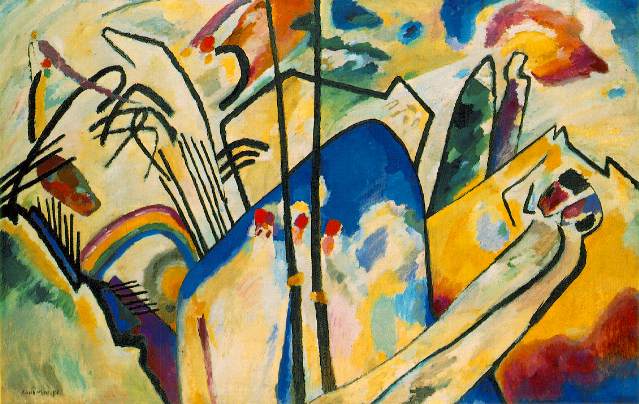In his work, On the Spiritual in Art, published 1911, Kandinsky divided his paintings into three categories: Impressions, Improvisations, and Compositions.
Impressions were observations of the natural world. One example, Impression III (Concert) was painted after Kandinsky attended a Schönberg concert in Munich in 1911.

The painting is dominated by the tension between the black and yellow colors. In On the Spiritual in Art, Kandinsky wrote, “Light yellow… on black… has such a strong effect that it flies off the background, floats in the air and jumps into the viewers’ eyes.”
“The black piano is the material source of sound, yellow, on the other hand, is the immaterial source. The yellow floods out to the side of the piano, flows downwards in a swinging movement, around the audience, and rises once again to the musicians in the orchestra, and from there finally settles as a round patch in front of the white, slanting columns.” (Günter Brucher: Kandinsky, Wege zur Abstraktion, München 1999, p. 284 f.)
Improvisations were spontaneous expressions of a mood or a feeling. One example is Improvisation 11 (1910). This Improvisation contains numerous allusions to the representational world: a dog in the foreground; a boat of people being rowed across a stormy lake; two cannons, a group of figures armed with lances, two galloping armed riders, and the suggestion of buildings. The animated composition can be said to be almost narrative.

Compositions were also the expression of inner visions, but on a grander, more ambitious scale. The most appropriate analogy for a Composition is that of a symphony, with their meticulous planning and complex structure. Between 1910 and 1939, Kandinsky painted ten large Compositions. Composition IV, below, still features partially identifiable objects and therefore is representational of a transitional stage on Kandinsky’s path to abstraction.

About this composition, Kandinsky wrote, “The whole composition is intended to produce a very bright effect, with many sweet colors, which often run into one another (dissolution), while the yellow, too, is cold. The juxtaposition of this bright-sweet-cold tone with angular movement (battle) is the principal contrast in the picture. It seems to me that this contrast is here, by comparison with Composition II, more powerful, but at the same time harder (inwardly), clearer, the advantage of which is that it produces a more precise effect, the disadvantage being that this precision has too great a clarity.”
– Kandinsky, Reminiscences, 1913. From Becks-Malorny p. 64. See “Useful References.”
In these Compositions, Kandinsky’s great stylistic advance was the turning away from perspective toward broader fields of color, using linear elements to create depth.
Kandinsky termed On the Spiritual in Art his most important theoretical work. In it, he expressed his beliefs that a work of art should not spring from an external model such as nature, but rather from an “internal necessity.” The subjectivity of outer appearances could be countered by a conception based on inner impressions. The power of the “spiritual” inner voice was the ultimate authority. Although Kandinsky himself acknowledged that he could not renounce the use of objects fully before 1914, this was acceptable as long as color and form grew out of an internal necessity.